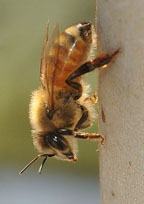
And most folks don’t know what it is.
But Extension apiculturist Eric Mussen, member of the Department of Entomology faculty at the University of California, Davis, and bee breeder-geneticist Susan Cobey, a researcher at both UC Davis and Washington State University, field dozens of queries about it.
Especially when the yellow-gold droppings splotch cars, businesses, houses and patios in large quantities. The droppings can streak windshields, block skylights, and stain clothing.
“Those little yellow-gold stains," Cobey said, "are bee feces.”
Or, what beekeepers commonly call “bee poop.”
Sacramento area TV station KCRA, Channel 3, interviewed Mussen on Aug. 24. Cobey has been interviewed by the Los Angeles Times and other media.
And, yes, sometimes, waste is a terrible thing to mind.
“It can get pretty messy, especially in the spring,” Cobey said. “It’s tough to remove—I soak it or wet it down and then wipe it off.”
However, if it’s found in large quantities in the hive, it can indicate a serious problem. “Nosema, for example, can cause dysentery,” she said. Nosema, identified as a fungus--a micro-sporidian--is a widespread disease of honey bees.
“Bee droppings have a very distinctive smell, an acidic smell,” Cobey said.
Mussen’s interview with KCRA news reporter Dea Diamont and news photographer Brian Fong, airs tonight (Aug. 26) at 6 and deals with a Patterson homeowner asking about the spots on the outside of her home. A clue: a beekeeper reportedly relocated a 40-hive apiary in the vicinity.
Honey bees are usually in the news for their pollination services or the latest research on latest colony collapse disorder (CCD), the mysterious phenomenon characterized by adult bees abandoning the hive, leaving behind the queen bee, brood, and stored food.
Curious minds, however, want to know "the scoop on poop."
Well, that's what the beekeepers call it.
Attached Images:

Visit to the UC Davis Apiary

Bee Defecation